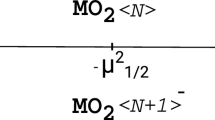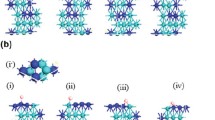Abstract
This work presents an extensive study for analyzing the adsorption mechanism of formaldehyde on pure and Pt-substituted rutile SnO2 (110) surfaces via the Density Functional Theory (DFT) method. Out of the two suitable surface sites for Pt-substitution, namely, Sn5c and Sn6c, the latter was found to be more suitable. Three formaldehyde configurations were considered, monodentate η1(O)-straight, monodentate η1(O)-tilted, and bidentate η2(O, C)-tilted. It was found that after Pt-substitution, the adsorption energies for η1(O)-tilted and η2(O, C)-tilted formaldehyde geometries were slightly improved. This improvement was found to be due to electron injection by Pt into the band gap of the surface combined with the stability of the formaldehyde orientation. Also, the overall adsorption energy values were better for the tilted configurations rather than those for the straight geometry. The changes in surface structure and bond lengths after optimization are seen to aid the adsorption mechanism by inducing steric effects and improved electrostatic interactions. Bader charge analysis shows two-fold interactions of charge transfer as well as only one-fold interaction in the cases of tilted and straight geometries respectively. Charge density difference (CDD) plots visually verified the above-stated results. The total density of states showed the injection of additional electronic states near zero energy (Fermi energy) level after Pt-substitution and an additional peak upon introduction of the gas molecule. PDOS plots were obtained to analyze the contribution of the orbitals of surface sites and the gas molecules to the gas adsorption mechanism. The recovery times for all the systems were obtained.






Similar content being viewed by others
Data and code availability
The entire data and code is available with the author and shall be produced if required.
References
H Liu, X Wang, C Pan and K M Liew J. Phys. Chem. C. 116 8044 (2012)
A Ahmadi, N L Hadipour, M Kamfiroozi and Z Bagheri Sens. Actuators B. 161 1025 (2012)
A Allouch, M Guglielmino, P Bernhardt, C A Serra and S Le Calvé Sens. Actuators B. 181 551 (2013)
J H E Arts, M A J Rennen and C de Heer Regul. Toxicol. Pharmacol. 44 144 (2006)
C Dong, Q Li, G Chen, X Xiao and Y Wang Sens. Actuators B. 220 171 (2015)
H Checkoway, P Boffetta, D J Mundt and K A Mundt Cancer Causes Control. 23 1747 (2012)
L R Rhomberg Regul. Toxicol. Pharmacol. 73 829 (2015)
M A Basyooni, S E Zaki, M Tihtih, I Boukhoubza, R En-nadir and G F Attia Handbook of nanosensors (Berlin: Springer) (2024)
M A Basyooni, M Kabatas, R En-nadir, K Rahmani and Y R Eker Micromachines. 14 1860 (2023)
D Xue, P Wang, Z Zhang and Y Wang Sens. Actuators B Chem. 296 126710 (2019)
N Yamazoe Sens. Actuators B Chem. 108 2 (2005)
J A Dirksen, K Duval and T A Ring Sens. Actuators B Chem. 80 106 (2001)
S Li, Z Lu, Z Yang and X Chu Sens. Actuators B Chem. 202 83 (2014)
M Tang, Z Zhang and Q Ge Catal. Today 274 103 (2016)
Y Sun, S Sun, Y Zhang, Z Zhang, T Hou, H Du and J Wang Appl. Surf. Sci. 570 15110 (2021)
A Umar, H Y Ammar, R Kumar, T Almas, A A Ibrahim, M S AlAssiri, M Abaker and S Baskoutas Int. J. Hydrog. Energy. 45 26388 (2020)
M A Abdulsattar, H H Abed, R H Jabbar and N M Almaroof J. Mol. Graph. Model. 102 107791 (2021)
F Jollet, M Torrent and N Holzwarth Comput. Phys. Commun. 185 1246 (2014)
T Daio, A Staykov, L Guo, J Liu, M Tanaka, S M Lyth and K Sasaki Sci. Rep. 5 13126 (2015)
T T Rantala, T S Rantala and V Lantto Mater. Sci. Semicond. 3 103 (2000)
A V Bandura, J O Sofo and J D Kubicki J. Phys. Chem. B. 110 8386 (2006)
F Wang, J Fan, Q Sun, Q Jiang, S Chen and W Zhou J. Nanomater. 2016 1 (2016)
S Nasresfahani, M H Sheikhi, M Tohidi and A Zarifkar Mater. Res. Bull. 89 161 (2017)
Y Xiao, Q Yang, Z Wang, R Zhang, Y Gao, P Sun, Y Sun and G Lu Sens. Actuators B Chem. 227 419 (2016)
P G Choi, N Izu, N Shirahata and Y Masuda Sens. Actuators B Chem. 296 126655 (2019)
F R Sensato, R Custodio, M Calatayud, A Beltran, J Andres, J R Sambrano and E Longo Surf. Sci. 511 408 (2002)
A V Bandura, J O Sofo and J D Kubicki J. Phys. Chem. B. 112 11616 (2008)
W Wei, Y Dai and B Huang J. Phys. Chem. C 115 18597 (2011)
L Liu and J Zhao Surf. Sci. 652 156 (2016)
J Haubrich, E Kaxiras and C M Friend Chem. Eur. J. 17 4496 (2011)
R Otero, A L Vasquez de Parga and J M Gallego Surf. Sci. Rep. 7 105 (2017)
G Henkelman, A Arnaldsson and H Jónson Comput. Mater. Sci. 36 354 (2006)
G Wang, Z Zhao, P Zhai, X Chen and Y Li Coatings. 11 1098 (2021)
J M R Muir and H Idriss Chem. Phys. Lett. 572 125 (2013)
S Peng, K Cho, P Qi and H Dai Chem. Phys. Lett. 387 271 (2004)
K Timsorn and C Wongchoosuk Mater. Res. Express 7 055005 (2020)
G Lee, G Yang, A Cho, J W Han and J Kim Chem. Chem. Phys. 18 14198 (2016)
Y Fang, D D Yang, C Y Xiang, M Shi, H Zhao and H Asadi J. Mol. Graph. 99 107630 (2020)
Funding
The author would like to thank DST-INSPIRE for providing the necessary funding in research as well as NIT Meghalaya for providing the requisite computational resources.
Author information
Authors and Affiliations
Contributions
SG performed the simulations and prepared the manuscript. AB supervised the work and revised the manuscript.
Corresponding author
Additional information
Publisher's Note
Springer Nature remains neutral with regard to jurisdictional claims in published maps and institutional affiliations.
Rights and permissions
Springer Nature or its licensor (e.g. a society or other partner) holds exclusive rights to this article under a publishing agreement with the author(s) or other rightsholder(s); author self-archiving of the accepted manuscript version of this article is solely governed by the terms of such publishing agreement and applicable law.
About this article
Cite this article
Gulshanah, S., Bhattacharjee, A. Pt-substituted rutile SnO2 (110) surface: first-principles study on its adsorption of formaldehyde. Indian J Phys (2024). https://doi.org/10.1007/s12648-024-03176-6
Received:
Accepted:
Published:
DOI: https://doi.org/10.1007/s12648-024-03176-6




